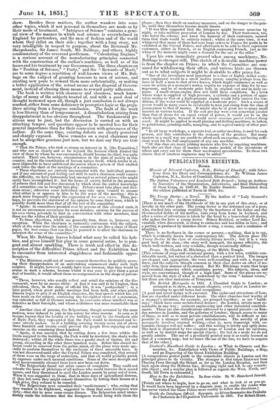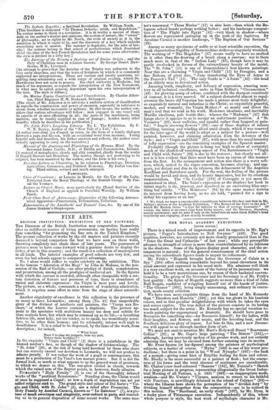PUBLICATIONS RECEIVED.
Boom.
Memoir of Edward Copleston, D.D., Bishop of .Llandaff ; with Selec- tions from his Diary and Correspondence, &c. By William James Copleston, M.A., Rector of Cromhall, Gloucestershire.
The Italian Volunteers and Lombard life Brigade; being an Authen- tic Narrative of the Organization, Adventures, and final Disbanding of these Corps; in 1848-49. By Emilio Dandolo. Translated from the edition published at Turin in 1849, &c.
The Young Doctor ; a Novel. By the Author of "Lady Granard's Nieces," &c. In three volumes.
[There is not much of the likelihoods of life in one part of this story, or of novelty in the other part. The young doctor is the deformed son of a peer, who, crushed into seeming stupidity by the harshness of his father and the ill-concealed dislike of his mother, runs away from home in boyhood, and after a series of adventures is taken by the hand by a benevolent old doctor, who makes the hero a young doctor. Sidney Beckford, or rather Lord Ra- venshill, when discovered, is rising to eminence and has fallen in love ; and a parting is produced by mistakes about a ring, a name, and a confusion of identities.
There is no freshness in the scenes or persons,—nothing, that is to say, which is evidently drawn from contemporary life. The defects place The Young Doctor in the class of circulating library novels ; but it is a very good book of its class,—the story well managed, the scenes effective, the whole well-written, and very readable, though occasionally diffuse.] Poems. By Charles H. Hitchings, of the Middle Temple. [This volume of songs and occasional poems, with a few tales, exhibits con- siderable merit, but rather of a rhetorical than a poetical kind. The images are elegant and appropriate, the verse well-sounding and with a degree of force, and the subjects though common in their class derive an effect of no- velty from their manner of treatment. But Mr. Hitchings wants that large and essential character which constitutes poetry. His subjects, ideas, and style, are conventional, though of a high kind. Some of the pieces are re- moved from the style of what is understood by the term "Annual verses," but these are close imitations of Tennyson.] The British Metropolis in 1851. A Classified Guide to London ; so arranged as to show, in separate chapters, every object in London in- teresting to special tastes and occupations. [A good and novel design well executed. The sights and attractions of Lon- don are classified under different heads. The older churches best worthy of a stranger's attention, for example, are grouped together ; so are "build- ings," which have some architectural feature; the London streets most re- markable in any way ; eminent engineering and other industrial establish- ments. There are also classifications addressed to a special pursuit—as Sun- day services in London, and the galleries of London ; though access to many of these, as well as to most private establishments, will be difficult or im- possible to a stranger without good introductions. The novelty of plan necessarily involves original wnting,—that is, mere transcript with co- lourable changes will not suffice ; and this writing is briefly and aptly done. The book is illustrated by two complete maps of London and its environs, as well as by district maps for special objects ; the last in a mode we do not greatly admire. The use of a peculiarly printed map is as easily learned as that of a common map ; but we know the use of the one, we have to acquire that of the other.] Limbird's Handbook Guide to London ; or What to Observe and Re- member, &c. Embellished with Views of Public Buildings, a Map, and an Engraving of the Great Exhibition Building. [A compendious pocket guide to the remarkable objects in London and the principal places in its vicinity. The stranger is first taken Eastward from Charing Cross through the Strand as far as the London Hospital, and then back again along the Holborn line, diverging right and left to any remark- able object •, and a similar plan is followed as regards the West, North, and South, till Town is exhausted.] How to See the Exhibition. In four visits. By W. Blanchard Jerrold. Visit the First. [Points out where to begin, how to go on, and what to look at as you go. It would have been improved by a diagram map, to enable the reader who has never visited the Glass Palace more readily to follow the directions.] Guide du Catalogue Officiel. Synopsis, ou RevueSommaire des Produita de ''Industrie de l'Exposition Universelle de 1851. Par Robert Hunt. The Infinite Republic; a Spiritual Revolution. By William North. [This brochure is dedicated "To Thomas Doherty, artist, and Republican." Its author seems to think it a revelation : it is in reality a species of rhap- sody on the author's studies and opinions, the system of nature, the "errors" of philosophy, set to rights by Mr. North, the evils of society as it is, the condition in which it ought to be, and the discovery of a key which unlocks everything seeu or unseen. The manner is dogmatic, for the sake of bre- vity ; the notions belong to that school of perfectionists which flourished about the time of the first French Revolution and for some years afterwards; the style is pitched in a lofty key.] The Doctrine of the Trinity a Doctrine not of Divine Origin ; and the Duty of Christian men in relation thereto. By George Stuart Haw- thorne, M.D., Liverpool. [An attempt to prove that the doctrine of the Trinity was unknown to the very early churches, and that the texts of Scripture by which it is commonly supported are interpolations. These are curious and knotty questions, re- Trunng deep scholarship and a wide range of original reading, which Dr. Hawthorne does not seem to possess. His chief authority is Alosheim; but much of his argument, as regards the interpolation of the New Testament, is what may be called general, dependent upon his own interpretation of the text. The style is diffuse.] On Marine Engine Construction and Classification. By Charles Ather- ton, Chief Engineer H. M. Dockyard, Devonport.
[The object of Mr. Atherton is to advocate a uniform system of classification as regards the construction and power of steamers, especially in reference to steam fleets, whether mercantile or military. By this means, the author con- siders that various advantages will follow : men engaged in one vessel will be capable of at once officiating in all; the parts of the machinery, being uniform, can be readily supplied in case of damage ; besides many other benefits, which he describes in his publication.]
The Little Folk's Laughing Library/. No. I. The Exhibition. By F. W. N. Bayley, Author of the "New Tale of a Tub," &c. [A rather over-done jeu d'esprit in verse, in the form of a family dialogue between a papa and his son, with an occasional word from mamma. Young hopeful asks and describes, his father answers and reflects, the author occa- sionally appearing to carry on the narrative.] Manual of the Anatomy and Physiology of the Human Mind. By the Reverend James Carlile, D.D., of Dublin and Parsonstown, Ireland. [A manual of metaphysics, closely and ably compiled, chiefly from the works of Dugald Stewart and Hamilton. The matter, though not professing to be original, has been mastered by the author, and the form is his own.] Familiar Letters on Chemistry/, in its relation to Physiology, Dietetics, Agriculture, Commerce, and Political Economy. By Justus von Lie- big. Third edition, revised and much enlarged.
Paarrittxrs.
Cases of Conscience ; or Lessons in Morals, for the Use of the Laity. Extracted from the Moral Theology of the Romish Clergy. By Pas- cal the Younger.
Lecture on Church Music, more particularly the Choral Service of the Church of England as applied to Parochial Worship. By William Spark.
First Class Book of Astronomy; illustrative of the following Astrono- mical Apparatus—Planetarium, Tellunarium, Tellurium.
Examination of the Landlords' and Tenants' Case, &e. By one of Sir James Graham's Shopkeepers.



























 Previous page
Previous page